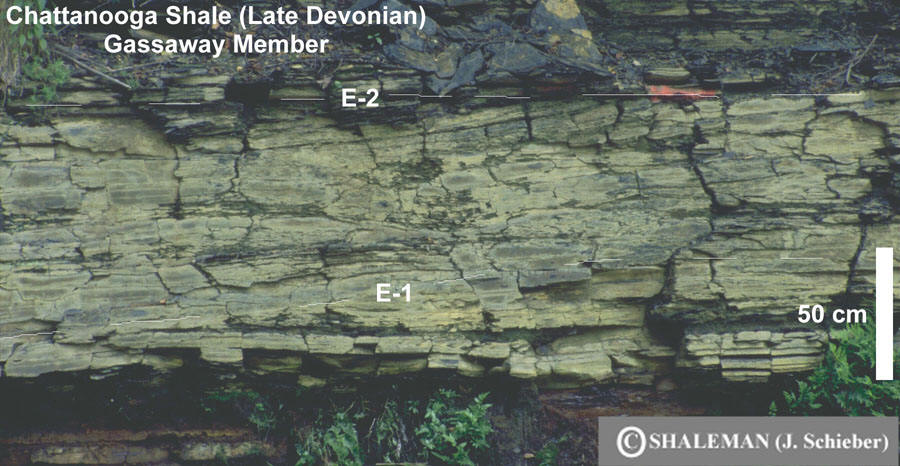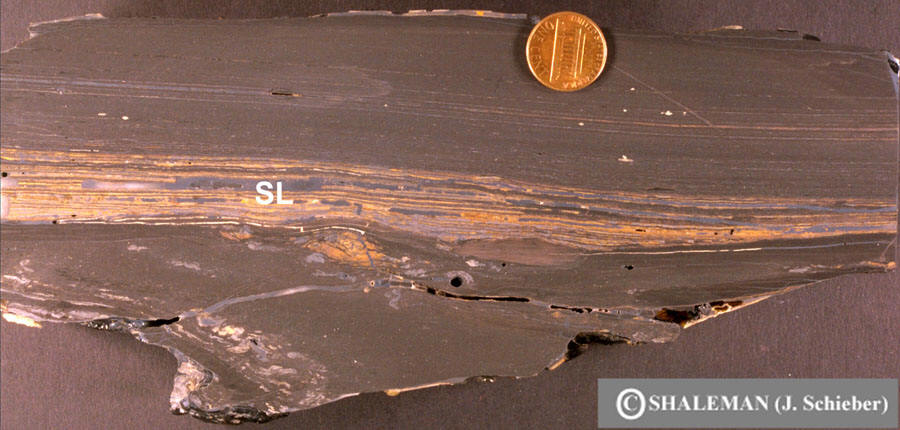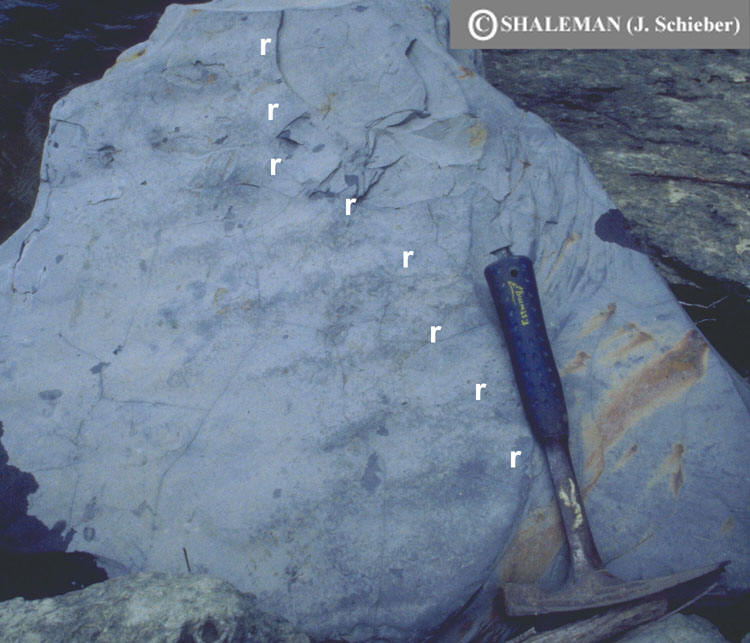
 |
|
|
|
|
|
|
|
|
Sculpting of Muddy Bottoms, Erosion Surfaces and Ripples |
|
| Sculpting of submarine mud
bottoms by currents and waves may be reflected in the sedimentary
record by erosion surfaces and related features. Examples shown on
this page are from the Chattanooga Shale (Late Devonian) of
Tennessee. Submarine erosion surfaces are a little known but
probably quite common feature of shallow marine shale successions.
Those of the Chattanooga Shale have been described in several
publications. Schieber, J., 1994, Evidence for episodic high energy events and shallow water deposition in the Chattanooga Shale, Devonian, central Tennessee, U.S.A. Sedimentary Geology, v. 93, p. 193-208. download PDF file (left click on link and click on "Save as"...) |
|
 |
|
| Outcrop of Dowelltown Member of
the Chattanooga Shale. Shows several inclined truncation surfaces
within black shales. Note angular truncation of beds beneath
truncation surfaces. Shales deposited after an erosive event are
conformable to the underlying erosion surface. Their draping over
these truncation surfaces produces a kind of pseudo
cross-stratification. BU = basal unconformity of the Chattanooga
Shale; T1 and T2 are truncation/erosion surfaces of probably
submarine origin. I consider them expressions of sequence
boundaries. Schieber, J., 1998, Sedimentary features indicating erosion, condensation, and hiatuses in the Chattanooga Shale of Central Tennessee: Relevance for sedimentary and stratigraphic evolution. In: J. Schieber, W. Zimmerle, and P. Sethi (editors), Shales and Mudstones (vol. 1): Basin Studies, Sedimentology and Paleontology, Schweizerbart’sche Verlagsbuchhandlung, Stuttgart, p. 187-215. download PDF file (left click on link and click on "Save as"...) |
|
 |
|
| Outcrop of Gassaway Member of
Chattanooga Shale. Shows again several inclined truncation/erosion
surfaces. Note angular truncation of beds beneath truncation
surfaces. E1 and E2 mark the erosion/truncation surfaces visible in
this exposure. Surface E2 has already been traced over a large
distance along the eastern Highland Rim (for about 150 km). The
large lateral extent strongly suggests that E2 is a bona fide
sequence boundary. Schieber, J., 1994, Reflection of deep vs shallow water deposition by small scale sedimentary features and microfabrics of the Chattanooga Shale in Tennessee. Canadian Society of Petroleum Geologists, Memoir 17, p. 773-784. Link |
|
 |
|
| Photo of polished slab showing details of an erosion surface as shown in Figs. 5/1 and 5/2. Erosion surface is overlain by a fine sandy to silty lag deposit (marked Sl) that is in turn overlain by black shales. Note how silt layers in underlying black shales show truncation and soft sediment deformation, and how shales above the erosion surface conformably overly it. | |
 |
|
| Photo of a bedding surface of black shale. Shows faintly visible parallel ripple crests (strike about 80 degrees relative to the vertical margin of photo, and are marked with r). There seems to be no silt or sand associated with these ripples, and their origin is as yet unclear. They do, however, suggest currents or waves interacting with the seabed. | |
|
|
|
| Back to SHALE RESEARCH LAB Main Page | |
| Back to IU Department of Geological Sciences | |
|
© Jürgen Schieber, IU Bloomington Department of
Geosciences Last updated: November 05, 2023. |
|